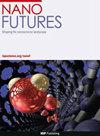Study of the tribological properties of nano lubricating oil blends for diesel engines
IF 2.5
4区 材料科学
Q3 MATERIALS SCIENCE, MULTIDISCIPLINARY
引用次数: 0
Abstract
The aim of this paper is to evaluate and compare the tribological properties of lubricating oil blends with added nano graphene and nano cerium oxide (CeO2) on the key friction pairs of diesel engines. Dispersion stability is the premise of the study of tribological properties. In this paper, nano CeO2 particles were self-made and high-quality nano graphene was purchased. The dispersion stability of the two nanomaterials in lubricating oil was studied after the same modification. According to the working conditions of the cylinder liner and piston ring, friction and wear tests of the lubricating oil blends containing the modified nanomaterials were carried out at different temperatures. The results showed that both nanomaterials were successfully modified with oleic acid and stearic acid. The dispersion stability of the modified nanomaterials in lubricating oil was improved. The dispersion stability of the lubricating oil blends with graphene before and after modification was slightly higher than that of lubricating oil blends with CeO2 before and after modification. At high temperature, the anti-friction properties of the two nano lubricating oil blends were similar. At ambient temperature, lubricating oil blends containing modified CeO2 did not play a role in reducing friction, while lubricating oil blends with modified graphene had the effect of reducing friction. Whether at ambient temperature or high temperature, the anti-wear property when lubricated with lubricating oil blends with modified CeO2 within the right concentration range was better than that when lubricated with lubricating oil blends containing modified graphene.柴油机用纳米润滑油共混物的摩擦学性能研究
本文的目的是评估和比较添加纳米石墨烯和纳米氧化铈(CeO2)的润滑油在柴油机关键摩擦副上的摩擦学性能。分散稳定性是研究摩擦学性能的前提。本文自制了纳米CeO2颗粒,并购买了高质量的纳米石墨烯。研究了两种纳米材料在相同改性后在润滑油中的分散稳定性。根据缸套和活塞环的工作条件,对含有改性纳米材料的润滑油混合物在不同温度下进行了摩擦磨损试验。结果表明,油酸和硬脂酸对两种纳米材料都进行了成功的改性。改性纳米材料在润滑油中的分散稳定性得到改善。改性前后石墨烯润滑油的分散稳定性略高于改性前后CeO2润滑油。在高温下,两种纳米润滑油共混物的抗摩擦性能相似。在环境温度下,含有改性CeO2的润滑油混合物没有起到减摩作用,而含有改性石墨烯的润滑油共混物具有减摩作用。无论在环境温度还是高温下,在合适的浓度范围内,用改性CeO2的润滑油共混物润滑时的抗磨性能都优于用改性石墨烯的润滑油润滑时的耐磨性能。
本文章由计算机程序翻译,如有差异,请以英文原文为准。
求助全文
约1分钟内获得全文
求助全文
来源期刊

Nano Futures
Chemistry-General Chemistry
CiteScore
4.30
自引率
0.00%
发文量
35
期刊介绍:
Nano Futures mission is to reflect the diverse and multidisciplinary field of nanoscience and nanotechnology that now brings together researchers from across physics, chemistry, biomedicine, materials science, engineering and industry.
 求助内容:
求助内容: 应助结果提醒方式:
应助结果提醒方式:


